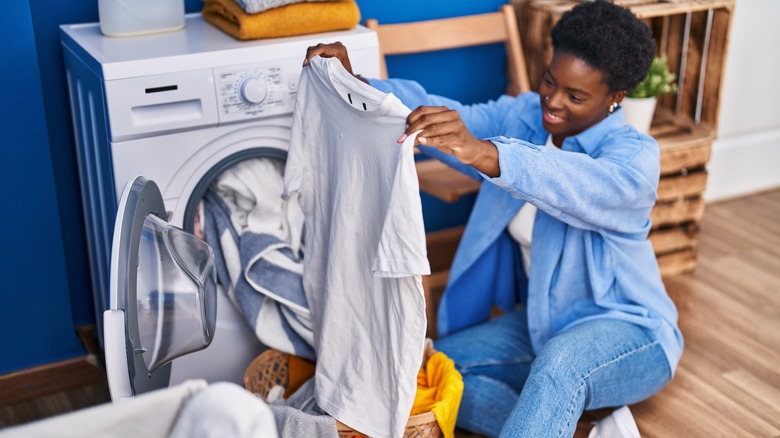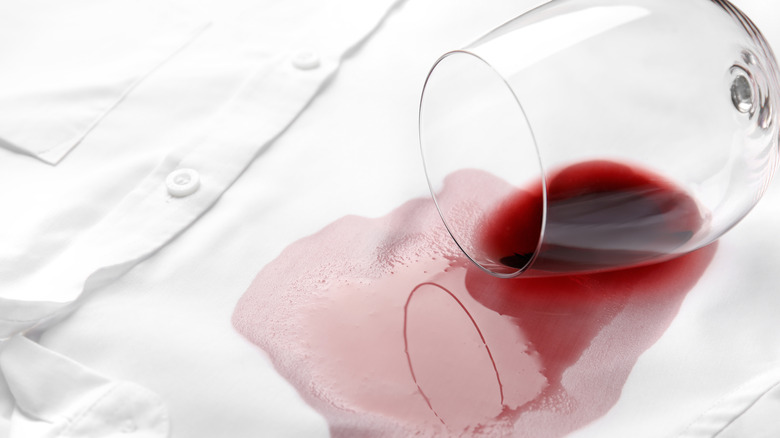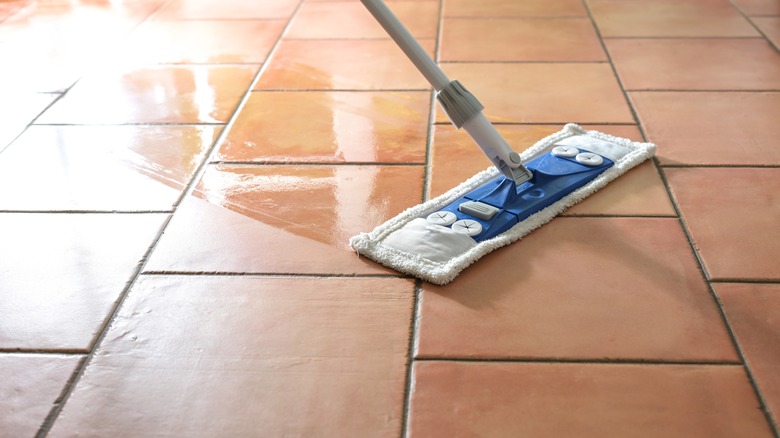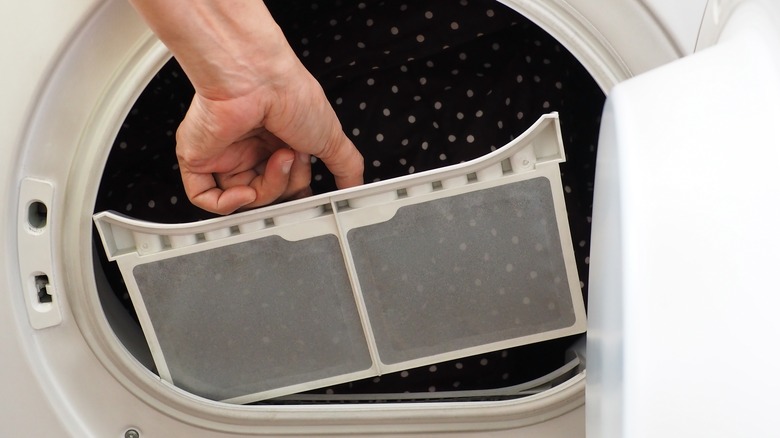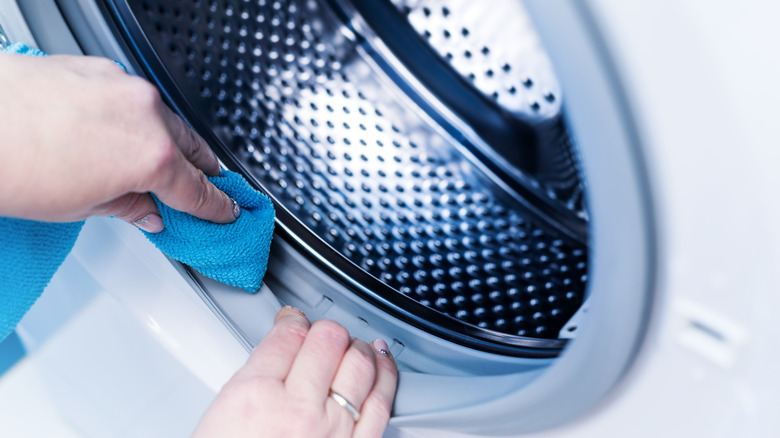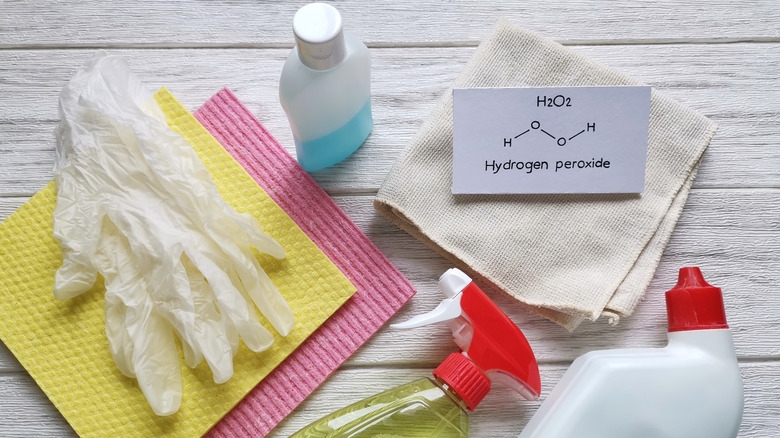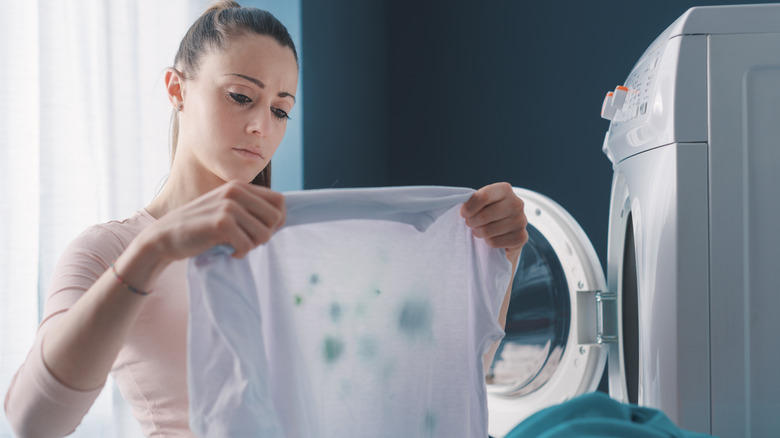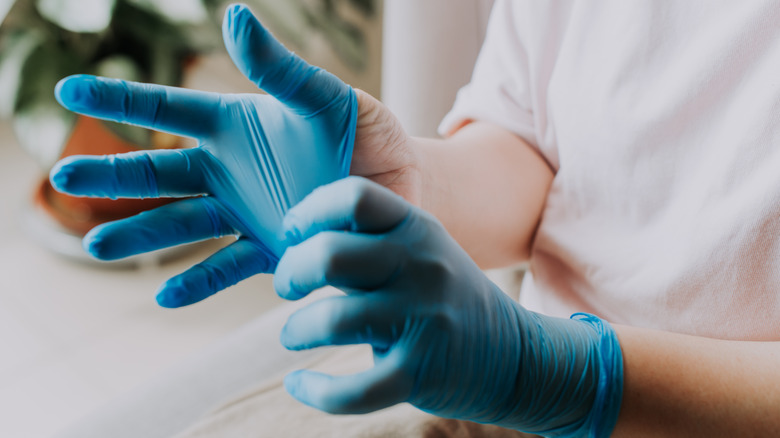4 Ways To Use Hydrogen Peroxide In The Laundry Room, And 3 Ways To Avoid
Hydrogen peroxide is a chemical agent that's widely available in drugstores. In fact, this antiseptic is now available in bottles, sprays, and wipes, usually in 3% strength formulations (the other 97% is water). Previously, hydrogen peroxide was used to treat mild skin injuries, such as cuts and scrapes, but now, such uses aren't recommended unless specifically directed by a medical professional.
However, before you get rid of a bottle of hydrogen peroxide, know that it may be reused for other purposes. Once widely stored in medicine cabinets, hydrogen peroxide has different uses inside your home. In fact, there are several surprising ways to use hydrogen peroxide in your home, including various applications in your laundry room. From cleaning various surfaces to lifting stains out of certain fabrics, this over-the-counter product can certainly multitask, but it's also just as important to know how not to use hydrogen peroxide in the laundry room to avoid harm to yourself or damage to your home.
Do use it to remove stains on white clothing and bedding
If you want to remove stubborn stains from white clothes and linens, you might consider hydrogen peroxide as an alternative to bleach. Not only does it work as a spot treatment for tough stains, but it can also be used as a cleaner to restore the whiteness of laundry that has lost its original brightness.
Hydrogen peroxide can be used as a stain remover instead of a commercial product by pouring or spraying a small amount directly on the stain. As with commercial stain removers, you'll want to leave the hydrogen peroxide on the stain in question before adding water. After a few minutes, you can rinse the garment or place it in the washing machine as part of a regular cycle. Another option is to pour hydrogen peroxide directly into a load of white clothing, towels, or linens. To use this method, Clean and Simple Cleaning recommends pouring one cup of hydrogen peroxide into the washing machine over the top of your laundry. Let the solution sit for 10 to 15 minutes before running a cycle.
Do clean floors in laundry room with it
While you may focus on cleaning floors in high-traffic areas of your home, such as your kitchen or living room, you may also neglect floors in your laundry room. Whether you're looking to get rid of a stubborn stain or want an all-around cleaner floor, you can safely use hydrogen peroxide on almost any flooring around your washing machine and dryer, including vinyl, tile, and laminate floors.
To use hydrogen peroxide on flooring, dilute the antiseptic with water and spray on floors before mopping, and then wipe them dry. This method can work with almost any type of flooring to kill germs while potentially getting them sparkling clean and looking new. However, while numerous blogs state that you can use hydrogen peroxide safely over hardwood flooring as long as you test it in a small area first, you're better off not taking this risk if your laundry room has hardwood floors. Using hydrogen peroxide on wood floors can be a mistake because the bleaching effects can discolor the wood.
Do use it to clean your lint trap
While you might regularly remove lint from your dryer's lint trap after every load of laundry, this important feature in your appliance needs occasional deep cleaning. Doing so not only helps remove lint and debris more thoroughly for cleaner clothing, but it can also help preserve the lifespan of your dryer because it won't have to work as hard to do its job. Using hydrogen peroxide is one way you can clean a dryer's lint trap safely and effectively. Not only does the antiseptic help to kill any germs that may be on your lint trap, but it can also help remove debris you can't remove by hand alone.
To clean a lint trap with this method, take the device out of the dryer. Spray or pour hydrogen peroxide directly onto the lint trap, ensuring the product is applied evenly across both sides. According to Love to Know, you can also make up a spray bottle of 1/4 cup hydrogen peroxide with a teaspoon of liquid laundry detergent. Next, use a sponge or clean cloth to scrub the lint trap. Rinse the lint trap underneath the sink to remove all traces of hydrogen peroxide before drying it with a separate clean cloth. Repeat the process, if necessary, until the lint trap is completely clean and free of debris. For best results, Love to Know recommends deep cleaning your lint trap in this way once a month to help keep your dryer clean.
Do use it to clean the inside of your washing machine
Getting your laundry truly clean requires that you have a spotlessly clean washing machine. This means more than wiping out the occasional piece of debris you might find after a load. Since they use water, washing machines are notorious for mildew buildup and potential mold growth, especially if you keep the lid closed in between uses. Even if it doesn't look dirty, any musty smell from your washing machine is a sign that it needs a deep cleaning immediately. While you can buy expensive washing machine cleaners, hydrogen peroxide can do the job just as well and without the expense of commercial products.
To use this method, Better Homes and Gardens recommends using two cups of hydrogen peroxide with your washing machine's hot cycle. Simply pour the solution directly into your washing machine, and your washing machine will take care of the rest. When the cycle is done, take a clean, dry cloth and wipe out any water or hydrogen peroxide left behind. Depending on how often you use your machine, Real Simple recommends cleaning this appliance two to four times per year.
Don't mix it with other cleaning products in your laundry room
Hydrogen peroxide may be a safe cleaning agent for certain fabrics and surfaces, but mixing it with other types of cleaning products can be dangerous. One of the most dangerous combinations is hydrogen peroxide and vinegar. When these are mixed, it creates a corrosive substance called peracetic acid. At the very least, peracetic acid can cause throat, skin, and eye irritation. In worst-case scenarios, peracetic acid can damage the lungs, leading to potentially fatal respiratory problems. Bleach is another chemical that creates a dangerous gas when mixed with hydrogen peroxide.
There are specific steps you can take to avoid these mistakes when cleaning with hydrogen peroxide. First, if you're using both vinegar and hydrogen peroxide for different purposes in the laundry room, make sure the first product is completely wiped off the surface before using the other. Also, consider ensuring your laundry room is well-ventilated before using any chemicals, whether alone or in alternation. If you're using hydrogen peroxide to remove stains from clothing, for example, do not use bleach simultaneously. Finally, as a rule of thumb, remember that the only thing that is safe to combine with hydrogen peroxide is plain water.
Don't pour it on colored clothing and sheets
While hydrogen peroxide is an easy way to get stains out of white linens, towels, and clothing, you should not use this substance on any colored fabrics. Doing so may have some unwanted effects. The stain may lift, but you may be left with larger areas of discoloration in its place. Using hydrogen peroxide to clean any vintage clothing you might have is especially risky, as you could find yourself in a situation where the chemical has ruined irreplaceable items.
Instead, leave hydrogen peroxide for use only on white clothing, sheets, and other fabrics. There are different options you can try for lifting stains from colored fabrics, with your safest options involving store-bought stain removers. Also, be sure to wash your items per the care labels, using cold or warm water as appropriate. Using hot water to remove stains can cause colors to run and may also shrink your clothing. Do not put clothing or linens in the dryer until you've removed the stain in question.
Don't forget to wear gloves and goggles when using hydrogen peroxide in the laundry room
Despite the fact hydrogen peroxide can safely clean and remove stains from certain fabrics and hard surfaces, this chemical can pose significant dangers to your skin. These can range from mild skin irritation to small exposures all the way to serious injuries from exposure to more concentrated versions. According to Harvard University, even concentrations of part water and less than 50% hydrogen peroxide may pose risks to your skin, and amounts as little as 10% can even be dangerous to your eyes, increasing the risk of permanent damage or vision loss. Even though hydrogen peroxide was previously used as a topical antiseptic, it's no longer recommended for these uses due to the risk of irritation and inhibited wound healing, per Banner Health.
Due to the dangers of this seemingly mild cleaning agent, you should always wear gloves while cleaning with hydrogen peroxide. Consider disposable latex gloves you can throw out after each use to prevent accidental skin exposure. You'll also want to ensure these fit your hands properly without being so loose that they fall off during cleaning. If your skin accidentally comes into contact with hydrogen peroxide, Harvard University recommends running the exposed area under water for at least 15 minutes. More serious burns require emergency medical attention.
